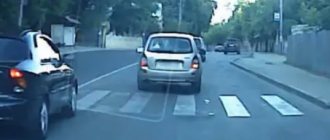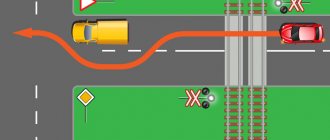What is the fine for not allowing a pedestrian to pass?
If a pedestrian had to change their trajectory or speed because of a car, the owner of this car will be fined from 1,500 to 2,500 rubles.
The traffic police officer decides what amount of fine to impose. He will look at the driver's violation history. If the motorist has already received a fine for such a maneuver or is a persistent offender, they will most likely issue a maximum fine of 2,500 rubles. If there are few violations or no similar offenses are noticed on the driver, they will issue a minimum fine of 1,500 rubles.
Fine for not letting a pedestrian pass
All vehicle drivers are required to give way to a pedestrian crossing the road in a designated place. The driver may be fined for not allowing a pedestrian to pass.
The fine in 2021 ranges from 1,500 to 2,500 rubles (according to Article 12.18 of the Administrative Code).
When determining the amount of the fine, the following facts are taken into account:
- The nature of the vehicle's movement.
- Markup quality.
- Visibility level.
- The driver's degree of awareness of his guilt.
Let us remind you that the fine was increased in October 2021, and the changes came into force in November of the same year.
Before this, the fine was fixed and amounted to 1,500 rubles, regardless of the nature of the vehicle’s movement, the quality of markings on the road, the level of visibility, the degree of awareness of guilt by the driver, and so on.
When is a fine issued for not allowing a pedestrian to pass?
In almost all cases, when a pedestrian appears on the roadway, the driver is obliged to give way to him. Let's consider all the situations described in the traffic rules:
- at a pedestrian crossing;
- when turning at an intersection;
- when entering and leaving the adjacent territory;
- for not allowing blind pedestrians to pass;
- for failure to pass on the way to public transport;
- on the side of the road - there the pedestrian should not be disturbed by riders on horses.
If a pedestrian finds himself in front of a car, he almost always has the right to cross the road in this place and should be allowed to pass
In what situations is a pedestrian in a privileged position?
From the explanations of the traffic police officer, I am obliged to give way to a pedestrian if he is in a preferential position. As I understand, there are a number of circumstances that obviously put a pedestrian in a position where the driver will have to give way. We will talk about the following points:
| Situation on the road | Actions of the car driver | Features and nuances |
| A citizen is at a pedestrian crossing | It is necessary to stop the vehicle to give way to a pedestrian already crossing the road or just entering the roadway | It is this point that is violated by drivers quite often and the majority of fines are issued for it. |
| When turning at an intersection | When turning, the driver must give way not only to pedestrians, but also to cyclists crossing that part of the roadway where the car is turning. | A driver at an intersection is required to give way in the following cases: |
- no transition markings;
- the driver is driving along the main road;
- The green light for the car is on, allowing you to turn;
- The pedestrian light is red.
- There is no need to give way only when the traffic is going straight and there is no crossing.
This is interesting: The procedure for conscription into military service
All described situations were simulated and analyzed in practice so that drivers could have a clear understanding of their actions when such circumstances arise.
Fine for repeated failure to allow a pedestrian to pass
There is no such fine. A violation is considered repeated if it is repeated within a year. If a driver fails to let a pedestrian pass three times in a year, the punishment will not increase; the second and third time there will be a fine in the same amount.
Severe penalties apply for other violations, such as running a red light, driving into oncoming traffic, or drunk driving. We wrote more about fines for repeated violations in our other article.
Amount of fine in 2021 for a driver if he does not let pedestrians pass
If the driver does not allow a person to cross a zebra crossing, he will be fined 1,500 rubles.
Evidence of guilt can be a recording from a traffic camera, eyewitness testimony, or the personal presence of a traffic police officer next to the offender at the time of the offense.
The driver will be punished with the same fine in the following cases:
- if the driver starts moving when the light is green, and the pedestrian does not have time to finish crossing the street;
- driver leaving the stop lane;
- a motorist did not let a pedestrian signal with a white cane;
- the motorist did not let people exiting public transport or heading to boarding;
- the driver did not allow a pedestrian to pass when turning right;
- the driver did not recognize the priority of a pedestrian in a residential area.
Important! For a car owner who has committed these violations, only administrative liability is provided.
When can you avoid a fine for failure to pass a pedestrian 2021
Let's consider situations where a driver has an advantage over a pedestrian. If an accident occurs, the motorist will be innocent.
A pedestrian crosses the road at a red traffic light. At traffic lights, pedestrians are prohibited from crossing to red.
The pedestrian was riding a bicycle. When crossing the road at a pedestrian crossing, the cyclist must step off onto the sidewalk and walk.
When driving in unequipped places. Without a pedestrian crossing, the road can be crossed at right angles to the edge of the road. It is prohibited to linger on the road or interfere with the passage of cars. This is stated in the traffic rules, in the section for pedestrians.
If the car owner's DVR records a pedestrian intentionally stopping on the road, this will help avoid a fine.
When crossing the road in prohibited places. A pedestrian can cross a road where there is no dividing strip or fences. But if a two-way road is separated by markings, a curb or a concrete barrier, crossing it is prohibited. If an accident occurs, the pedestrian will be in the wrong. This is written in the traffic rules.
To prove innocence will help:
- DVR. The recording can be shown to the traffic police officer who stopped you for the violation. If he refuses to look, later attach them to the complaint and submit to the traffic police;
- photo and video materials from the camera. Often a traffic police officer looks at only one photo and decides whether to issue a fine. At the Center for Automated Recording of Administrative Offenses in the Field of Traffic (CAFAP), you can obtain the entire series of photographs and even video recordings, if the camera has the technical capability.
What must a pedestrian observe?
When crossing, a pedestrian must adhere to certain rules:
- If the transition is unregulated. In this case, the pedestrian has the right to cross the road within this crossing. Pedestrians have the right of way, and drivers are required to give way to them.
- If the transition is adjustable. In this case, the pedestrian has the right to cross the road within this crossing only if there is a permit signal. If a pedestrian started moving at a permissive signal, but at some point in the movement a prohibiting signal was given, the pedestrian must continue moving (and drivers are required to let such a pedestrian pass).
- Blind pedestrians have the right to cross the road anywhere. However, at the same time they must give a special prohibiting signal with a white cane. If a blind pedestrian does not have a cane or gives the wrong signal, then he is deprived of the right to cross the road anywhere.
- It is prohibited to stop at a pedestrian crossing (even if the crossing is controlled and a permitting signal has been given).
- It is prohibited to cross the road outside a pedestrian crossing.
- If there is a traffic jam on the road, the pedestrian retains the right to cross the road at a pedestrian crossing.
- Pedestrians are required to give way to vehicles with blue flashing lights turned on (an example of such a vehicle is an ambulance).
This is interesting: Why do you need a copy of the work book?
How a pedestrian's refusal to cross a zebra crossing is recorded by cameras
The cameras are located at intersections where pedestrians are most often hit. The device calculates the trajectory of the car and the pedestrian as soon as the car is in its visibility range. If the camera notices that a pedestrian has changed speed, direction or stopped, the driver will receive a fine. The Moscow Traffic Management Center (TCOC) announced this on its official Twitter account.
Grigory Shukhman, expert on photo-video recording systems In practice, this happens: the pedestrian did not actually change the trajectory and speed, but the driver still receives a fine with one or two photographs. In this case, file a complaint with TsAFAP, where there should be an expanded set of materials - best of all, a video recording that will allow you to study the situation in dynamics. And based on the results of the review, the inspector may agree that there is no violation and cancel the fine.
What to do if you receive a fine for not allowing a pedestrian to pass
Depending on the situation, there are three options: challenge the fine, pay half or the entire amount.
Challenge the fine. The driver has the right to appeal the decision of the traffic police, even if the basis for the fine was photo and video materials from traffic cameras. Reasons why a fine can be challenged:
- the traffic camera made a mistake - the car had the wrong license plate or the pedestrian was too far away;
- the markings or sign were not visible - for example, due to fog or snowfall;
- the driver was absent from the scene of the violation.
The driver can appeal the decision within 10 days from the date of the document. The date can be viewed on the paper order or when checking the “Traffic Police Fines”.
The date of the decision is in the upper left corner
The grounds for appeal are best supported by the dash cam footage. Write it down on a flash drive or disk and submit it to the traffic police officer along with your complaint. The answer will be given within 10 days. Read more about how to appeal fines from cameras from the State Traffic Safety Inspectorate, MADI or AMPP in our other article.
If the traffic police refuses, the driver has the right to go to court
Pay with a discount. If the driver agrees with the ruling, he can save on paying the fine. The law allows you to pay a fine with a 50% discount in the first 20 days from the date of the decision. If a driver receives a fine of 2,500 rubles for not allowing a pedestrian to pass, in the first 20 days he can only pay 1,250 rubles.
Pay the full amount. If the letter arrived late and the driver received the letter for 21 days, he has another 40 days to pay the fine, but at full cost. If you wrote out 2500, this is the amount you need to pay. In order not to rely on mail and not to miss notifications about fines, subscribe to them on the “Staff Traffic Police Fines”.
Remember
- Giving way to a pedestrian means stopping and not moving so that his speed and trajectory do not change.
- The fine for not allowing a pedestrian to pass is from 1,500 to 2,500 rubles.
- You can receive a fine if you do not allow a pedestrian to pass at a crossing, on the side of the road, when entering and leaving the adjacent territory, as well as for not allowing a blind pedestrian to pass.
- A fine can be avoided if a pedestrian did not cross the road according to the rules: he walked on a red light, did not get off his bike at an intersection, crossed the road in unequipped or prohibited places.
- If the camera mistakenly accepted the driver’s maneuver as not allowing a pedestrian to pass and the driver received a fine, this decision of the traffic police can be appealed. DVR recording will help with this. Write the file to disk and attach it to the complaint to the traffic police.
- The deadline for paying a fine for not allowing a pedestrian to pass is 70 days from the date of the decision.
All articles by the author: Evgeniy Lesnov
Didn't let a pedestrian pass at a zebra crossing, how to prove your innocence and avoid a fine
First, you need to figure out what the fine is for not letting a pedestrian pass. According to Article 12.18 of the Code of Administrative Offenses of the Russian Federation, if you do not provide an advantage to a pedestrian at the moment when he has already started moving along the crossing, then you will face a fine of 1,500 rubles.
Failure to comply with the requirement of the Traffic Rules to give way to pedestrians, cyclists or other road users (except for vehicle drivers) who have the right of way in traffic shall entail the imposition of an administrative fine in the amount of one thousand five hundred to two thousand five hundred rubles.
Article 12.18 of the Code of Administrative Offenses of the Russian Federation
Now that we know about the punishment, let's figure out how to prove innocence if you did not give way to a pedestrian.
- Initially, you should wait for the inspector to introduce himself, present his ID and state the reasons for the stop.
- If your violation was recorded using technical means, then, of course, it would be better to simply agree with the accusation and pay a fine. But if there was no fixation, then it’s worth fighting.
- Ask the traffic police officer to draw up a protocol and invite the pedestrian to include his information in the protocol.
- Further, you can independently explain to the pedestrian that if the crossing was unsafe (the pedestrian jumped onto a zebra crossing in front of the car), then a fine should be issued to him too. The inspector, in turn, cannot prevent you from doing this, since on the basis of Part 1 of Article 25.1 of the Code of Administrative Offenses of the Russian Federation and Part 1 of Article 51 of the Constitution of the Russian Federation, he is obliged to do this himself.
A person against whom proceedings are being conducted for an administrative offense has the right to familiarize himself with all the materials of the case, give explanations, present evidence, file petitions and challenges, use the legal assistance of a defense attorney, as well as other procedural rights in accordance with this Code.
Part 1 of Article 25.1 of the Code of Administrative Offenses of the Russian Federation
No one is obliged to testify against himself, his spouse and close relatives, whose circle is determined by federal law.
Part 1 of Article 51 of the Constitution of the Russian Federation
- After this, the pedestrian automatically becomes a witness. Therefore, he will try to prove that you did not create any interference with him, otherwise he will also be fined.
- If the inspector refuses to call the pedestrian, citing the fact that he has already left, or is too far, in this case the violation will be considered absent, since without a pedestrian, it will be very difficult to prove that you did not give way, unless, of course, a photo was taken or video recording of the violation.
As for trams and people getting off, the driver is not required to brake once the tram stops. The passenger will not be considered a pedestrian until he steps onto the roadway; therefore, you are not obligated to stop so that people can get out.










